Silicon Waveguide Sensors for Carbon Dioxide Gas Sensing in the Mid-Infrared Region
Abstract
1. Introduction
2. Principle and Proposed Structure
3. Simulations and Results
4. Discussion
5. Conclusions
Author Contributions
Funding
Institutional Review Board Statement
Informed Consent Statement
Data Availability Statement
Acknowledgments
Conflicts of Interest
References
- Gibson, D.; MacGregor, C. A Novel Solid State Non-Dispersive Infrared CO2 Gas Sensor Compatible with Wireless and Portable Deployment. Sensors 2013, 13, 7079–7103. [Google Scholar] [CrossRef]
- Li, X.; Zhuang, Z.; Qi, D.; Zhao, C. High sensitive and fast response humidity sensor based on polymer composite nanofibers for breath monitoring and non-contact sensing. Sens. Actuators B Chem. 2020, 330, 129239. [Google Scholar] [CrossRef]
- Liu, Z.; Zheng, C.; Chen, C.; Li, Y.; Xie, H.; Ren, Q.; Wang, Y.; Tittel, F.K. ICL-based mid-infrared carbon dioxide sensor system for deep-sea natural gas hydrate exploration. Opt. Express 2019, 27, 5598–5609. [Google Scholar] [CrossRef] [PubMed]
- Pandey, S.K.; Kim, K.H. The Relative Performance of NDIR-based Sensors in the Near Real-time Analysis of CO2 in Air. Sensors 2007, 7, 1683–1696. [Google Scholar] [CrossRef] [PubMed]
- Vincent, T.A.; Gardner, J.W. A low cost MEMS based NDIR system for the monitoring of carbon dioxide in breath analysis at ppm levels. Sens. Actuators B Chem. 2016, 236, 954–964. [Google Scholar] [CrossRef]
- Weigel, C.; Grewe, A.; Sinzinger, S.; Hoffmann, M. A microoptical sidestream cuvette based on fast passive gas exchange for capnography. Sens. Actuators A Phys. 2018, 276, 68–75. [Google Scholar] [CrossRef]
- Yazici, M.S.; Dong, B.; Hasan, D.; Sun, F.; Lee, C. Integration of broadband MEMS IR detector with MIR waveguides for sensing applications. Opt. Express 2020, 28, 11524–11537. [Google Scholar] [CrossRef] [PubMed]
- Zhang, Y.; Zou, J.; Cao, Z.; He, J.J. Temperature-insensitive waveguide sensor using a ring cascaded with a Mach-Zehnder interferometer. Opt. Lett. 2019, 44, 299–302. [Google Scholar] [CrossRef]
- Xie, Z.; Cao, Z.; Liu, Y.; Zhang, Q.; Zou, J.; Shao, L.; Wang, Y.; He, J.; Li, M. Highly-sensitive optical biosensor based on equal FSR cascaded microring resonator with intensity interrogation for detection of progesterone molecules. Opt. Express 2017, 25, 33193–33201. [Google Scholar] [CrossRef]
- Prasad, P.R.; Selvaraja, S.K.; Varma, M.M. High precision measurement of intensity peak shifts in tunable cascaded microring intensity sensors. Opt. Lett. 2016, 41, 3153–3156. [Google Scholar] [CrossRef] [PubMed]
- Mi, G.; Horvath, C.; Aktary, M.; Van, V. Silicon microring refractometric sensor for atmospheric CO2 gas monitoring. Opt. Express 2016, 24, 1773–1780. [Google Scholar] [CrossRef] [PubMed]
- Mi, G.; Horvanth, C.; Van, V. Silicon photonic dual-gas sensor for H2 and CO2 detection. Opt. Express 2017, 25, 16250–16259. [Google Scholar] [CrossRef] [PubMed]
- Li, H.; Sun, B.; Yuan, Y.; Yang, J. Guanidine derivative polymer coated microbubble resonator for high sensitivity detection of CO2 gas concentration. Opt. Express 2019, 27, 1991–2000. [Google Scholar] [CrossRef] [PubMed]
- El Shamy, R.S.; Khalil, D.; Swillam, M.A. Mid infrared optical gas sensor using plasmonic Mach-Zehnder interferometer. Sci. Rep. 2020, 10, 1239. [Google Scholar] [CrossRef]
- Saeidi, P.; Jakoby, B.; Pühringer, G.; Tortschanoff, A.; Stocker, G.; Dubois, F.; Spettel, J.; Grille, T.; Jannesari, R. Designing mid-infrared gold-based plasmonic slot waveguides for CO2 sensing applications. Multidiscip. Digit. Publ. Inst. 2021, 21, 2269. [Google Scholar] [CrossRef] [PubMed]
- Chandar, V.; Ranjan, R. Performance analysis of different slot waveguide structures for evanescent field based gas sensor applications. Opt. Quantum Electron. 2021, 53, 457–472. [Google Scholar] [CrossRef]
- Kumari, B.; Barh, A.; Varshney, R.; Pal, B. Silicon-on-nitride slot waveguide: A promising platform as mid-IR trace gas sensor. Sens. Actuators B Chem. 2016, 236, 759–764. [Google Scholar] [CrossRef]
- Butt, M.A.; Khonina, S.N.; Kazanskiy, N.L. Silicon on silicon dioxide slot waveguide evanescent field gas absorption sensor. J. Mod. Opt. 2018, 65, 174–178. [Google Scholar] [CrossRef]
- Butt, M.A.; Degtyarev, S.A.; Khonina, S.N.; Kazanskiy, N.L. An evanescent field absorption gas sensor at mid-IR 3.39μm wavelength. J. Mod. Opt. 2017, 64, 1892–1897. [Google Scholar] [CrossRef]
- Rothman, L.S.; Jacquemart, D.; Barbe, A.; Benner, D.C.; Birk, M.; Brown, L.R.; Carleer, M.R.; Chackerian, C., Jr.; Chance, K.; Coudert, L.E.A. The HITRAN 2004 molecular spectroscopic database. J. Quant. Spectrosc. Radiat. Transf. 2005, 96, 139–204. [Google Scholar] [CrossRef]
- Hill, C.; Gordon, I.E.; Kochanov, R.V.; Barrett, L.; Wilzewski, J.S.; Rothman, L.S. HITRAN online: An online interface and the flexible representation of spectroscopic data in the HITRAN database. J. Quant. Spectrosc. Radiat. Transf. 2016, 177, 4–14. [Google Scholar] [CrossRef]
- Koompai, N.; Chaisakul, P.; Limsuwan, P.; Le Roux, X.; Vivien, L.; Marris-Morini, D. Design and simulation investigation of Si3N4 photonics circuits for wideband on-chip optical gas sensing around 2µm optical wavelength. Sensors 2021, 21, 2513. [Google Scholar] [CrossRef] [PubMed]
- Ranacher, C.; Tortschanoff, A.; Consani, C.; Moridi, M.; Grille, T.; Jakoby, B. Photonic Gas Sensor Using a Silicon Strip Waveguide. Multidiscip. Digit. Publ. Inst. Proc. 2017, 1, 547. [Google Scholar]
- Huang, Y.; Kalyoncu, S.K.; Zhao, Q.; Torun, R.; Boyraz, O. Silicon-on-sapphire waveguides design for mid-IR evanescent field absorption gas sensors. Opt. Commun. 2014, 313, 186–194. [Google Scholar] [CrossRef]
- Soref, R.A.; Emelett, S.J.; Buchwald, W.R. Silicon waveguided components for the long-wave infrared region. J. Opt. A Pure Appl. Opt. 2006, 8, 840–848. [Google Scholar] [CrossRef]
- Sibert, R.; Muller, J. Infrared integrated optical evanescent field sensor for gas analysis Part I: System design. Sens. Actuators A Phys. 2005, 119, 138–149. [Google Scholar] [CrossRef]
- Ruan, Z.; Zhou, N.; Zheng, S.; Cao, X.; Long, Y.; Chen, L.; Wang, J. Releasing the light field in subwavelength grating slot microring resonators for athermal and sensing applications. Nanoscale 2020, 12, 15620–15630. [Google Scholar] [CrossRef]
- Bock, P.J.; Cheben, P.; Schmid, J.H.; Lapointe, J.; Delâge, A.; Janz, S.; Aers, G.C.; Xu, D.-X.; Densmore, A.; Hall, T.J. Subwavelength grating periodic structures in silicon-on-insulator: A new type of microphotonic waveguide. Opt. Express 2010, 18, 20251–20262. [Google Scholar] [CrossRef]
- Zou, Y.; Subbaraman, H.; Chakravarty, S.; Xu, X.; Hosseini, A.; Lai, W.-C.; Wray, P.; Chen, R.T. Grating coupled silicon-on-sapphire integrated slot waveguides operating at mid-infrared wavelengths. Opt. Lett. 2014, 39, 3070–3073. [Google Scholar] [CrossRef]
- Feng, N.N.; Sun, R.; Kimerling, L.C.; Michel, J. Lossless strip-to-slot waveguide transformer. Opt. Lett. 2007, 32, 1250–1252. [Google Scholar] [CrossRef]
- Butt, M.A.; Khonina, S.N.; Kazanskiy, N.L. Ultrashort inverted tapered silicon ridge-to-slot waveguide coupler at 1.55µm and 3.392µm wavelength. Appl. Opt. 2020, 59, 7821–7828. [Google Scholar] [CrossRef] [PubMed]
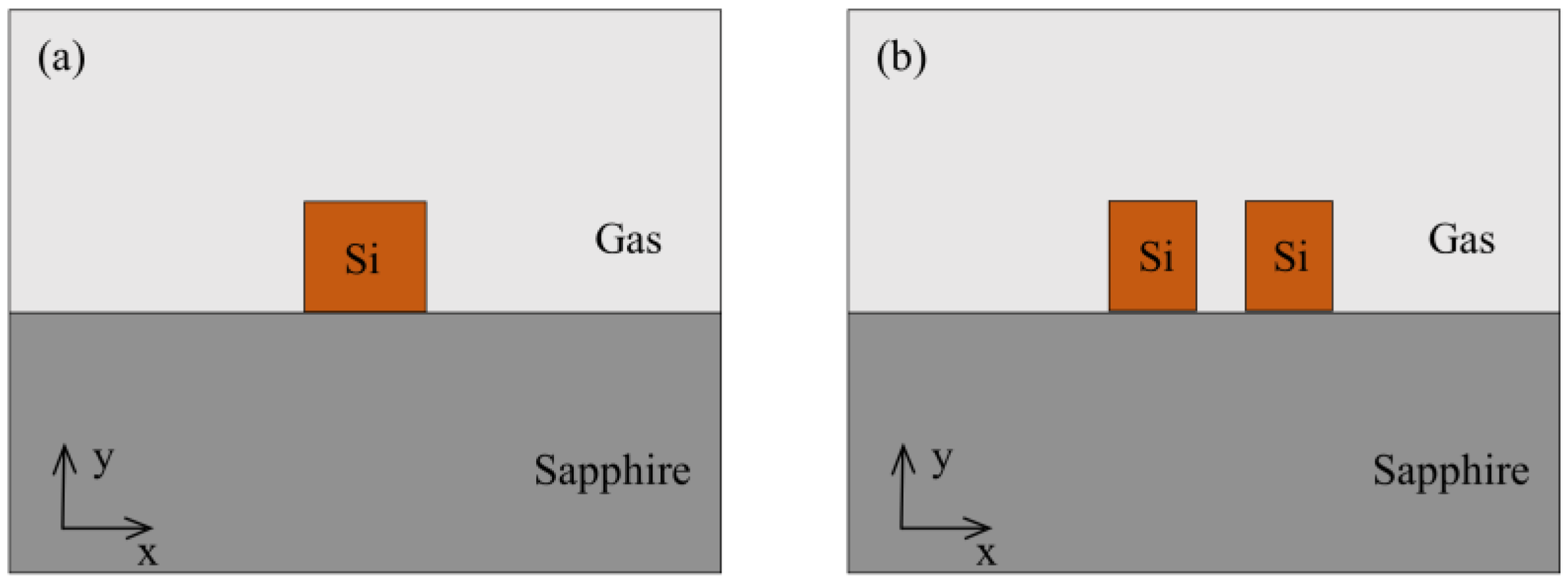

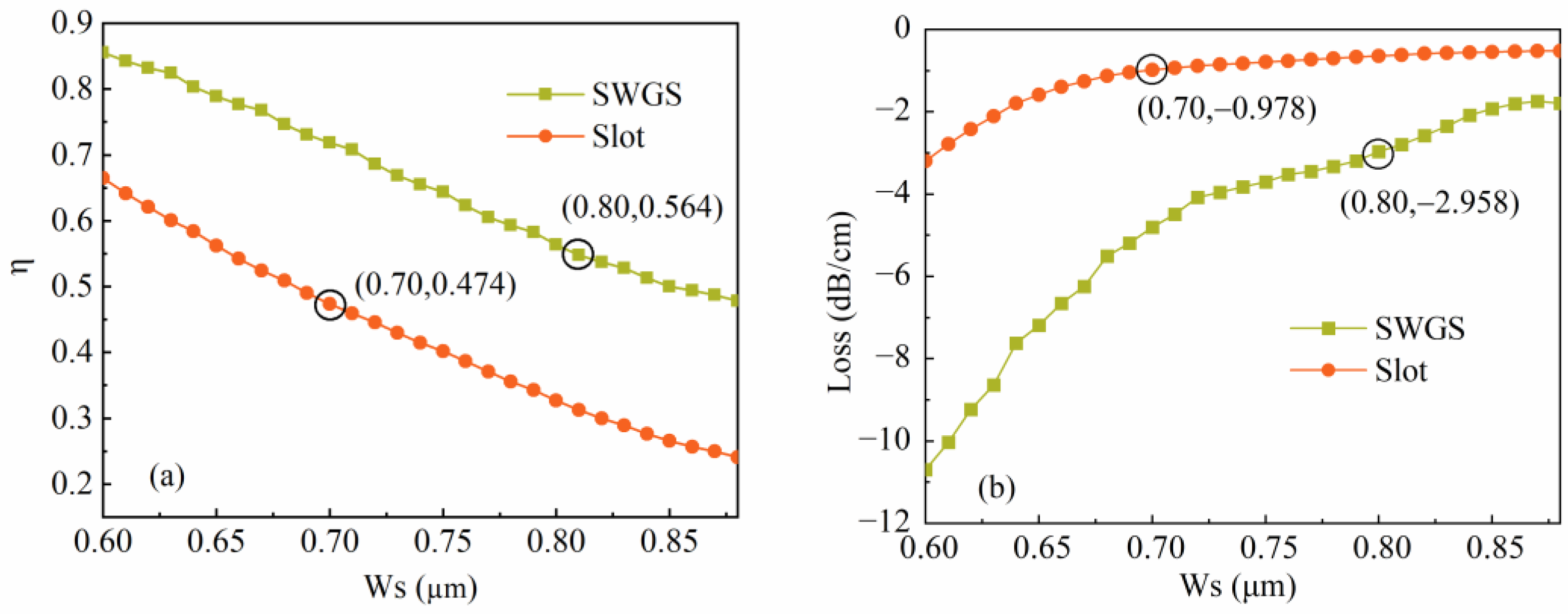
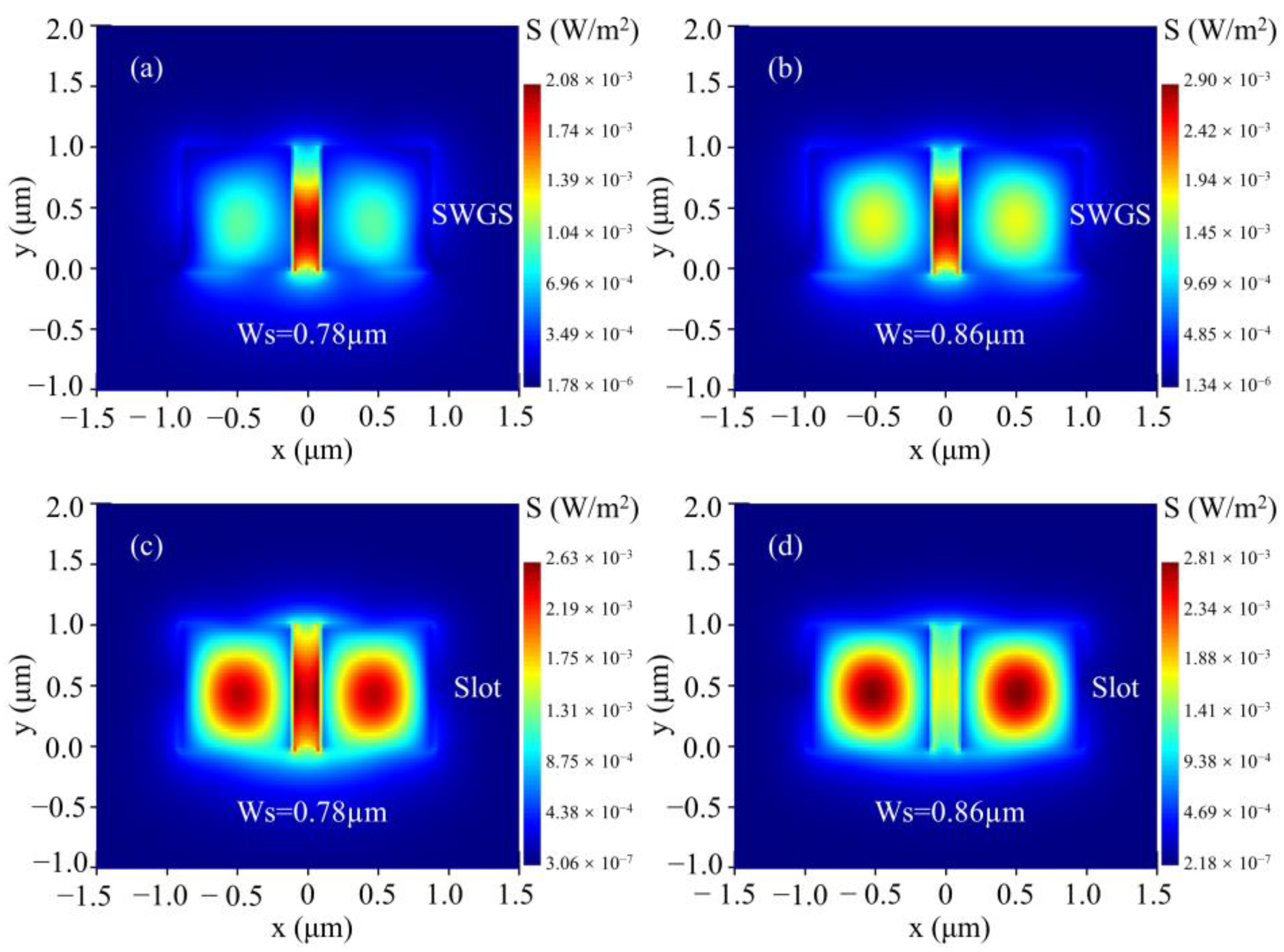
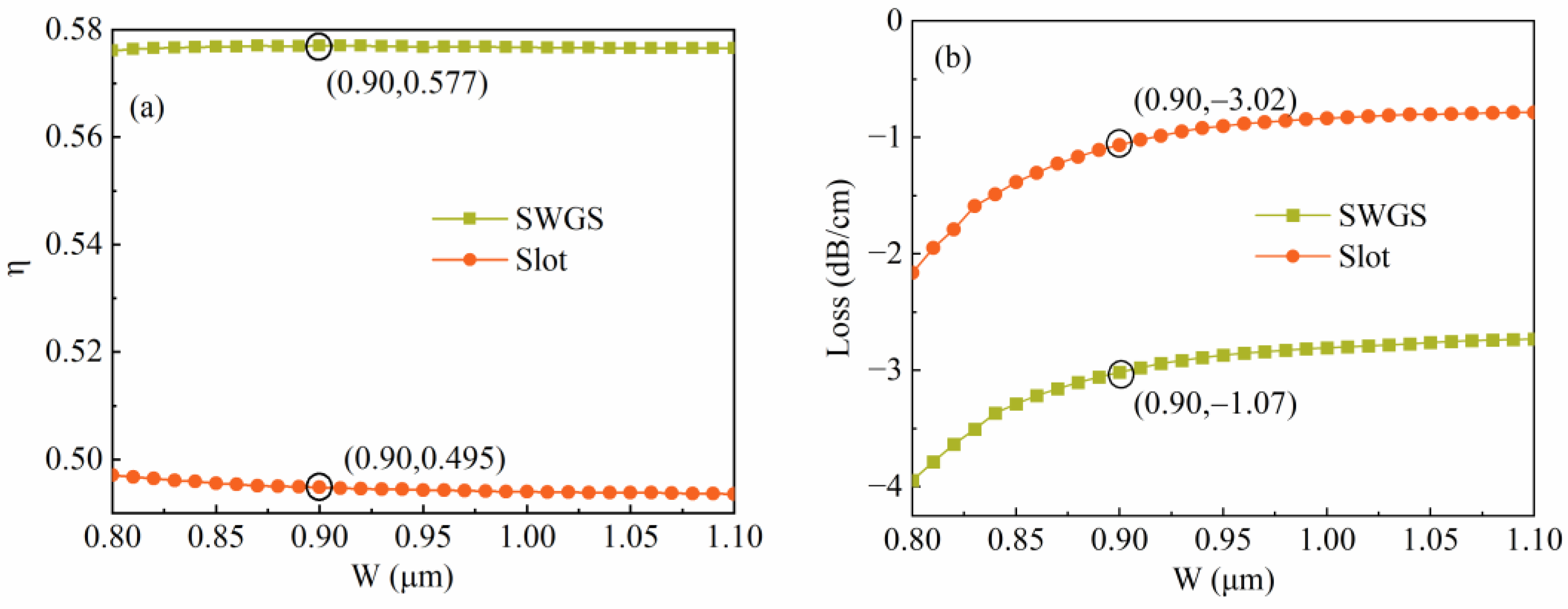

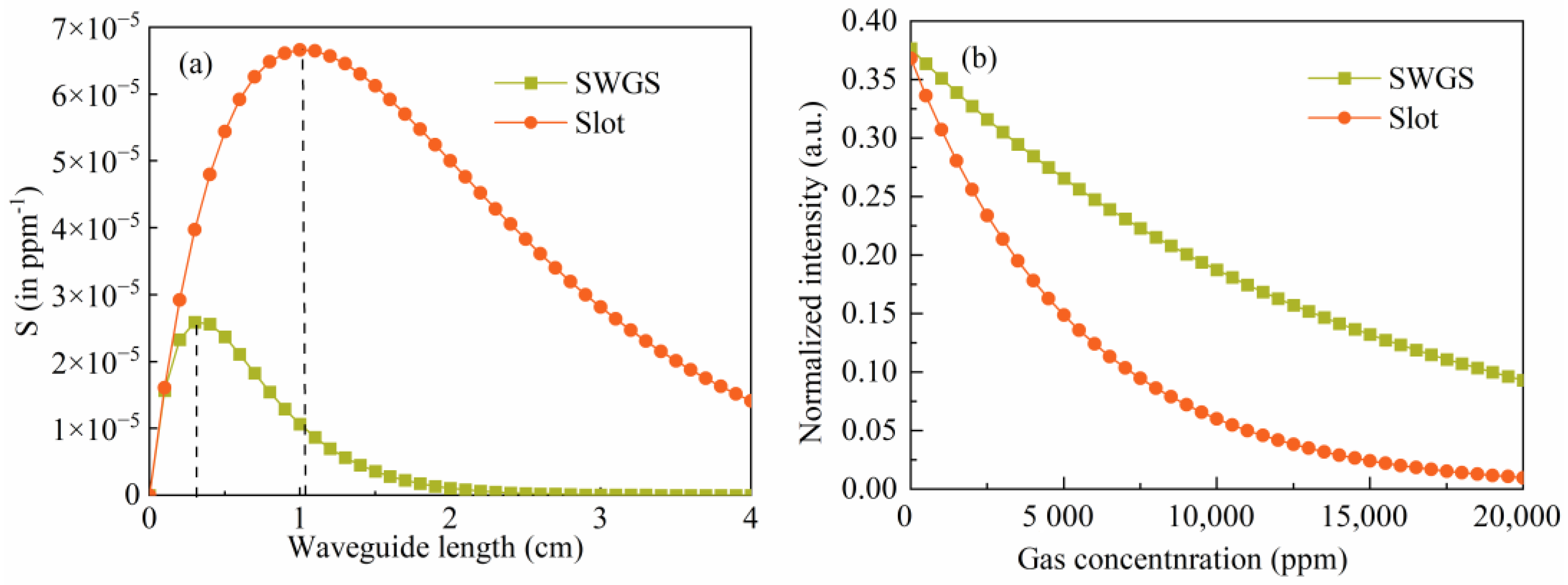
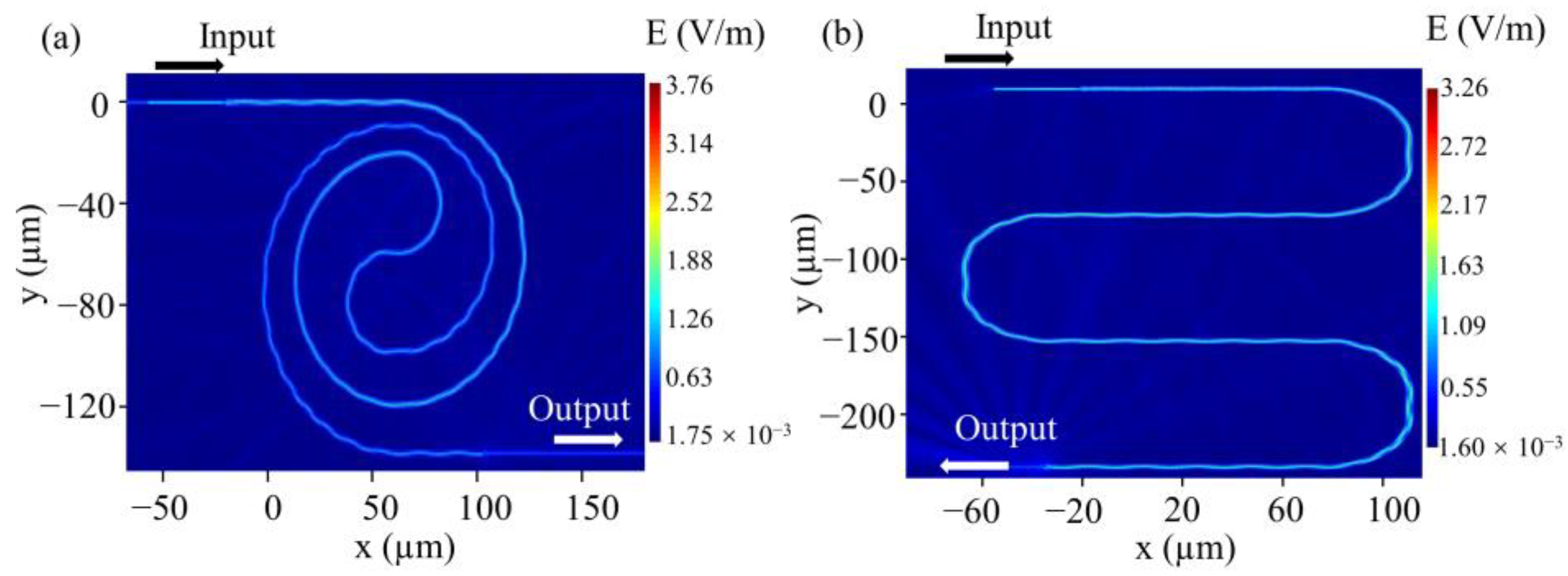
| Waveguide Type | Strip | SWG | Slot | SWGS |
|---|---|---|---|---|
| Structure |  |  |  | 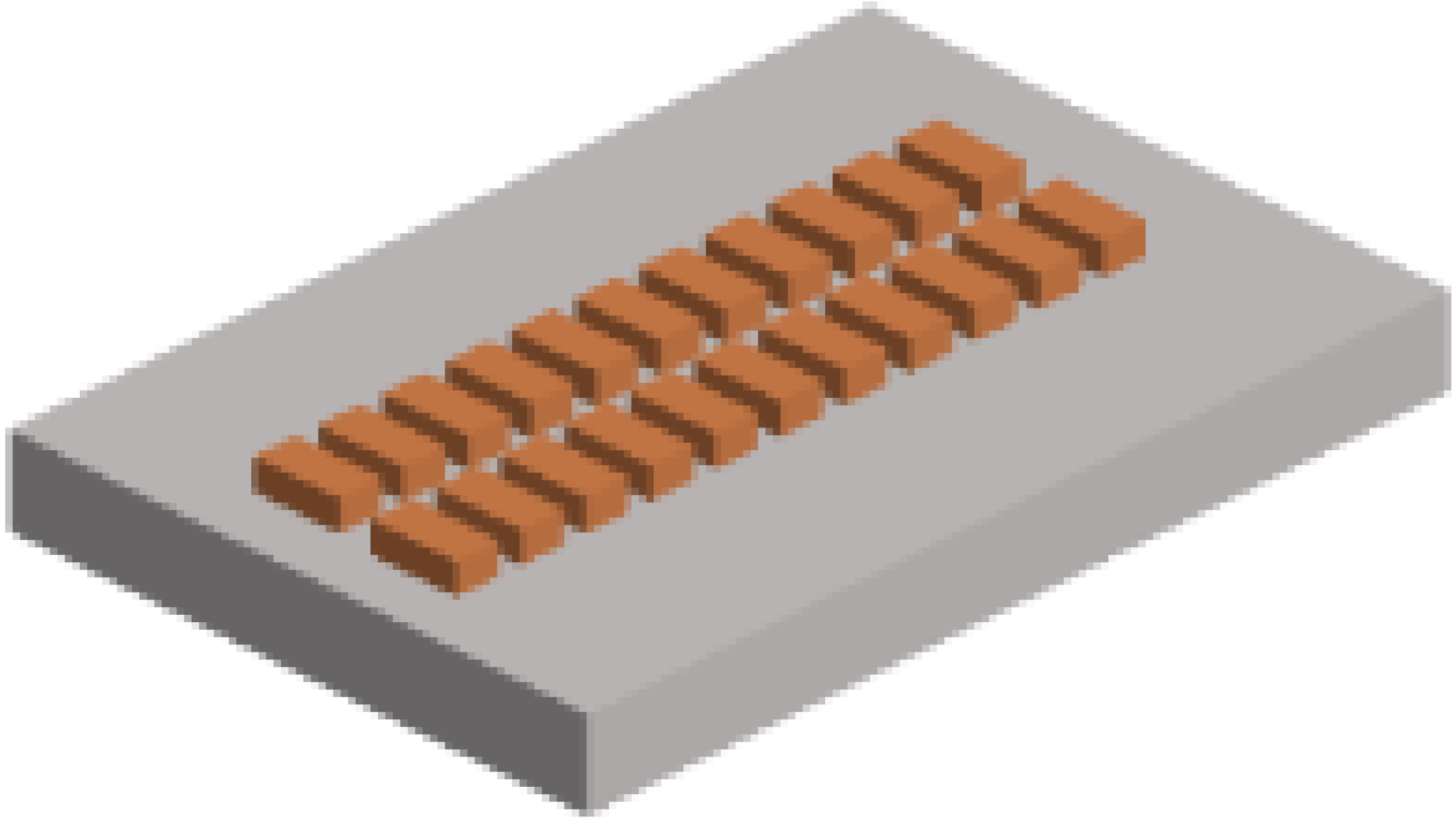 |
| Mode profile |  |  | 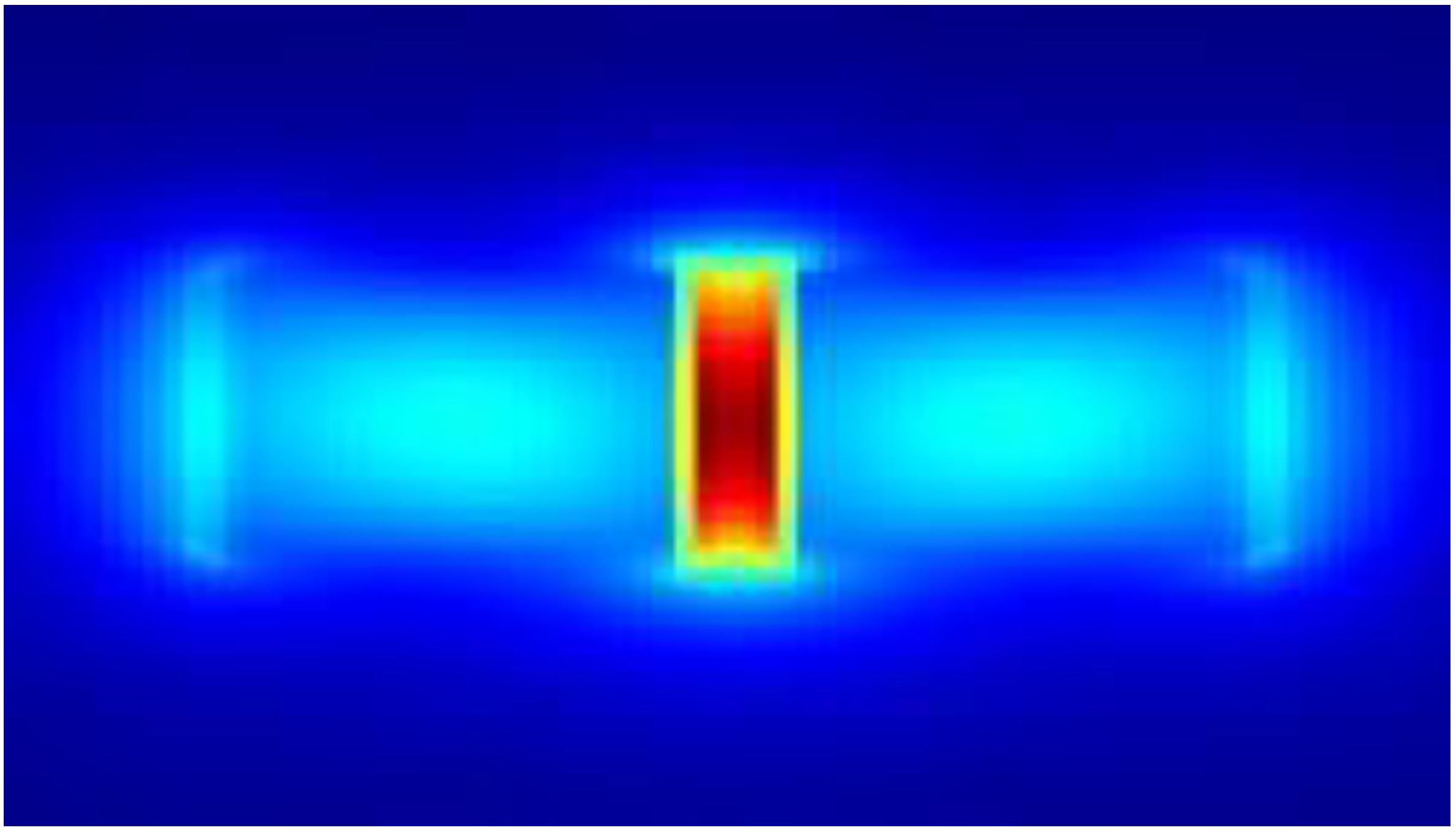 |  |
| η | 0.15 | 0.38 | 0.47 | 0.56 |
| Loss (dB/cm) | 0.023 | 1.54 | 0.98 | 2.96 |
| Waveguide Type | Wavelength (μm) | Parameters Sizes (μm) | η |
|---|---|---|---|
| SWGS [27] | 1.55 | H = 0.34; Ws = 0.30; Gap = 0.10; p = 0.20; a = 0.10 | 0.69 |
| Slot [17] | 3.00 | H = 1.70; Ws = 0.43; Gap = 0.10 | 0.43 |
| Slot [24] | 4.23 | H = 0.60; W = 1.00 | 0.14 |
| Slot [24] | 4.23 | H = 0.60; Ws = 1.60; Gap = 0.20 | 0.27 |
| Slot (our research work) | 4.23 | H = 1.00; Ws = 0.70; Gap = 0.20 | 0.47 |
| SWGS (our research work) | 4.23 | H = 1.00; Ws = 0.80; Gap = 0.20; p = 2.00; a = 0.30 | 0.56 |
Disclaimer/Publisher’s Note: The statements, opinions and data contained in all publications are solely those of the individual author(s) and contributor(s) and not of MDPI and/or the editor(s). MDPI and/or the editor(s) disclaim responsibility for any injury to people or property resulting from any ideas, methods, instructions or products referred to in the content. |
© 2023 by the authors. Licensee MDPI, Basel, Switzerland. This article is an open access article distributed under the terms and conditions of the Creative Commons Attribution (CC BY) license (https://creativecommons.org/licenses/by/4.0/).
Share and Cite
Song, Y.; Li, B.; Zhang, H.; Li, M.; Li, Q.; He, J.-J. Silicon Waveguide Sensors for Carbon Dioxide Gas Sensing in the Mid-Infrared Region. Photonics 2023, 10, 120. https://doi.org/10.3390/photonics10020120
Song Y, Li B, Zhang H, Li M, Li Q, He J-J. Silicon Waveguide Sensors for Carbon Dioxide Gas Sensing in the Mid-Infrared Region. Photonics. 2023; 10(2):120. https://doi.org/10.3390/photonics10020120
Chicago/Turabian StyleSong, Yuxia, Baoshuai Li, Huiyuan Zhang, Mingyu Li, Qiushun Li, and Jian-Jun He. 2023. "Silicon Waveguide Sensors for Carbon Dioxide Gas Sensing in the Mid-Infrared Region" Photonics 10, no. 2: 120. https://doi.org/10.3390/photonics10020120
APA StyleSong, Y., Li, B., Zhang, H., Li, M., Li, Q., & He, J.-J. (2023). Silicon Waveguide Sensors for Carbon Dioxide Gas Sensing in the Mid-Infrared Region. Photonics, 10(2), 120. https://doi.org/10.3390/photonics10020120





